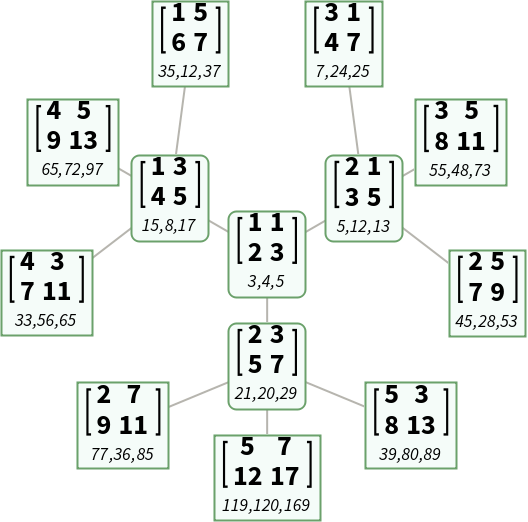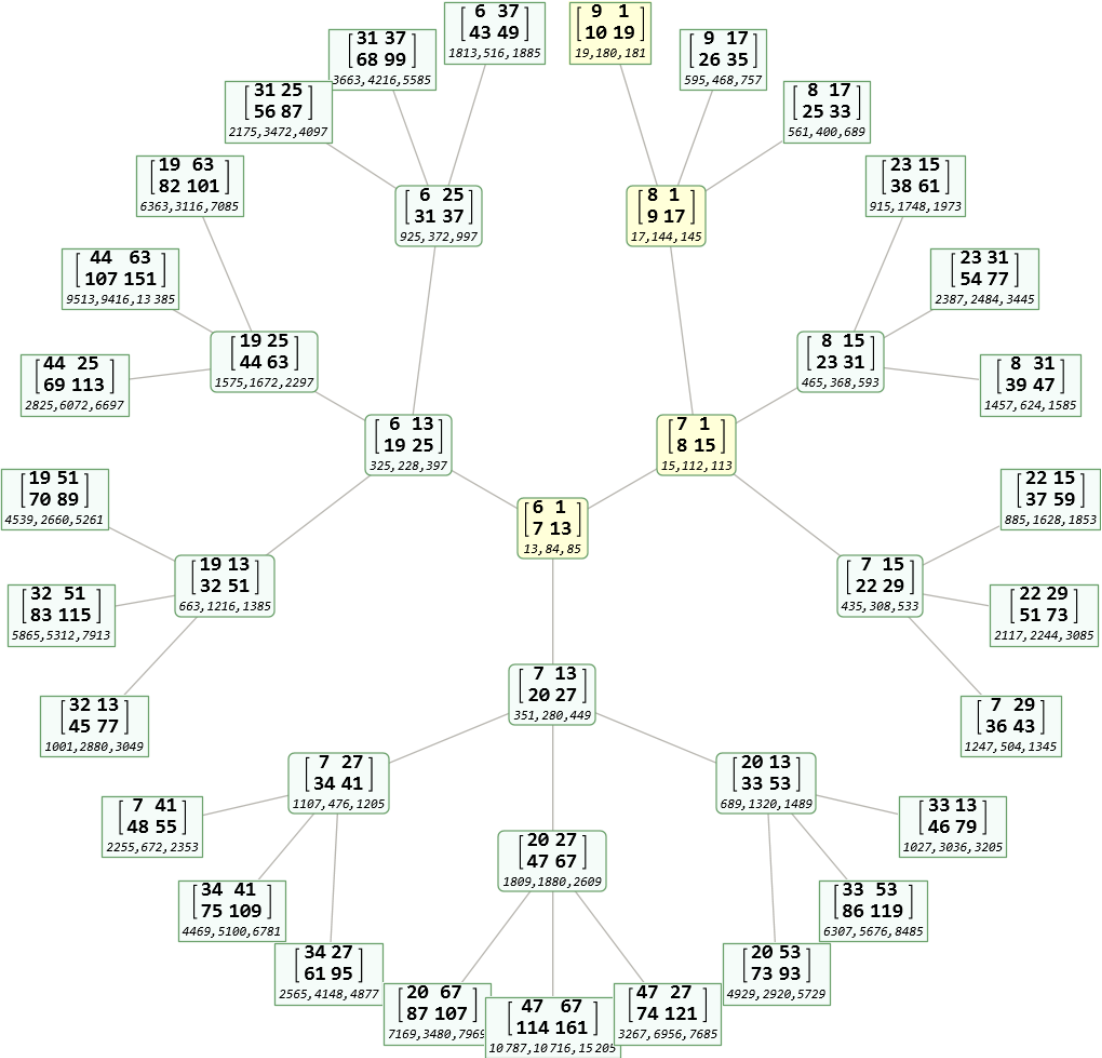Wolfram Function Repository
Instant-use add-on functions for the Wolfram Language
Function Repository Resource:
Generate primitive Pythagorean triples in a tree form using Fibonacci matrices
ResourceFunction["BarningHallTree"][n] creates an n level Barning-Hall tree with Fibonacci matrices as the nodes. | |
ResourceFunction["BarningHallTree"][n,"PythagoreanTriples"] creates a tree with primitive Pythagorean triples as the nodes. | |
ResourceFunction["BarningHallTree"][n,"LabeledWithPythagoreanTriples"] labels the Fibonacci matrices with corresponding primitive Pythagorean triples. |
Create a two level Barning-Hall (B-H) tree with Fibonacci matrices as nodes:
| In[1]:= |
| Out[1]= |  |
Use "LabeledWithPythagoreanTriples" property to display the B-H tree together with its associated primitive Pythagorean triples:
| In[2]:= |
| Out[2]= |  |
TreeExtract can be used to look up a certain node. To find a primitive Pythagorean triple containing 185, search for Fibonacci matrices that corresponding to a2+b2=1852 or a2+1852=c2 for some positive integer (a,b,c):
| In[3]:= |
| Out[3]= |  |
| In[4]:= |
| Out[4]= |
There are three valid solutions up to tree level 5:
| In[5]:= |
| Out[5]= |
We can verify the solution with Reduce:
| In[6]:= | ![{Reduce[a^2 + b^2 == 185^2 && a < b && GCD[a, b] == 1, {a, b}, PositiveIntegers],
Reduce[a^2 + 185^2 == c^2 && a < c && GCD[a, c] == 1 && c < 1000, {a,
c}, PositiveIntegers]}](https://www.wolframcloud.com/obj/resourcesystem/images/71b/71b9c497-ac70-464d-8e49-42dad0524bb1/4c085d4acabe418e.png) |
| Out[6]= |
The zeroth tree node is the root node:
| In[7]:= |
| Out[7]= |
The zeroth tree node corresponds to the smallest Pythagorean triangle with legs 3 and 4 and hypotenuse 5:
| In[8]:= |
| Out[8]= |  |
A Barning-Hall tree grows exponentially. BarningHallTree contains a limit of 12 and returns unevaluated for larger values:
| In[9]:= |
| Out[9]= |
Find Pythagorean triples (a,b,c) such that a<b<c and c-b=1. Some examples are (3,4,5) and (5,12,13). We can use the B-H tree function to find more:
| In[10]:= |
| In[11]:= |
| Out[11]= |
Find the corresponding Fibonacci matrices (notice that each matrix is the parent of matrix to the right):
| In[12]:= |
| Out[13]= |
Illustrate the path by highlighting the last four elements in the list above with LightYellow:
| In[14]:= | ![Tree[TreeExtract[labeled, {3, 3, 3, 3, 3}], TreeLayout -> "RadialEmbedding", TreeElementStyle -> {{} -> LightYellow, {3} -> LightYellow, {3, 3} -> LightYellow, {3, 3, 3} -> LightYellow}]](https://www.wolframcloud.com/obj/resourcesystem/images/71b/71b9c497-ac70-464d-8e49-42dad0524bb1/528941ec5f67a69e.png) |
| Out[14]= |  |
Directly generate Fibonacci matrices beginning with the same root node:
| In[15]:= | ![Short[MatrixForm /@ (res = NestList[
With[{a = #[[2, 1]], b = #[[1, 2]]}, {{a, b}, {a + b, 2 a + b}}] &, {{2, 1}, {3, 5}}, 100
])]](https://www.wolframcloud.com/obj/resourcesystem/images/71b/71b9c497-ac70-464d-8e49-42dad0524bb1/4f3fc15a236e397c.png) |
| Out[15]= |  |
Compute the triple for each matrix:
| In[16]:= | ![Short[NumericalSort@*
Function[{grid}, {2 grid[[1, 1]] grid[[2, 1]], grid[[1, 2]] grid[[2, 2]], grid[[1, 1]] grid[[2, 2]] + grid[[1, 2]] grid[[2, 1]]}] /@ res]](https://www.wolframcloud.com/obj/resourcesystem/images/71b/71b9c497-ac70-464d-8e49-42dad0524bb1/70f8b84412e11bd7.png) |
| Out[16]= |
Check that the results are correct by for a random triple from the list above:
| In[17]:= |
| Out[17]= |
All hypotenuses in these triples are associated with the following OEIS sequence:
| In[18]:= |
| Out[18]= |
Wolfram Language 14.0 (January 2024) or above
This work is licensed under a Creative Commons Attribution 4.0 International License